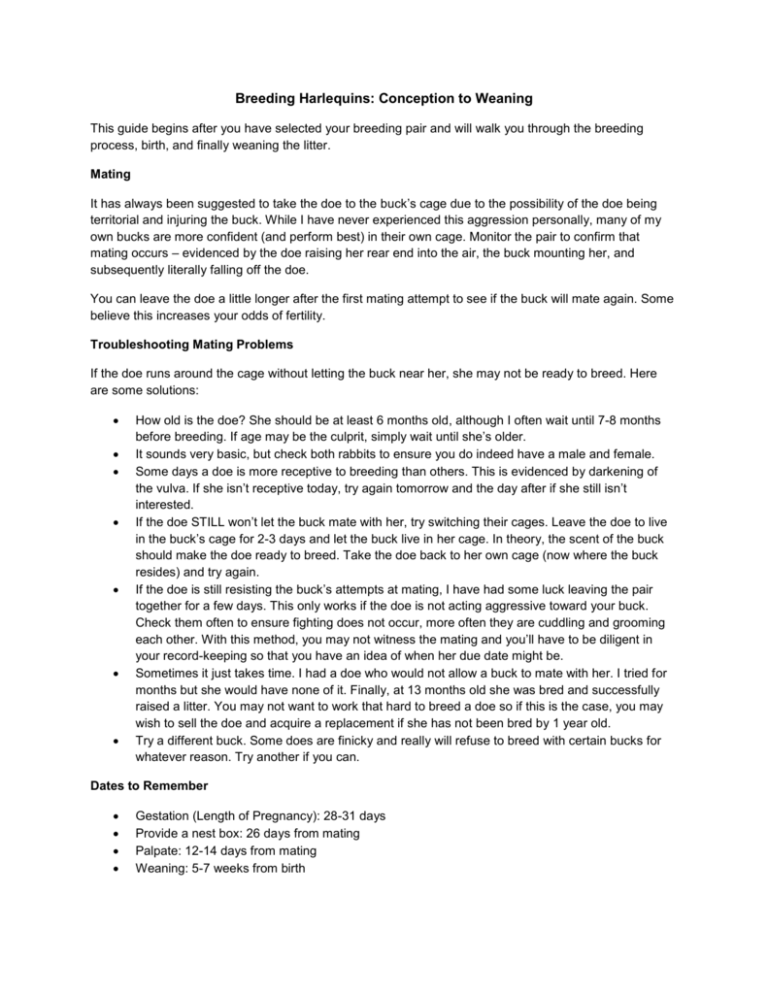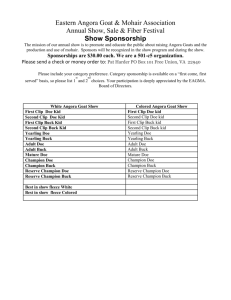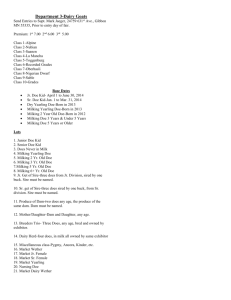File
advertisement

Breeding Harlequins: Conception to Weaning This guide begins after you have selected your breeding pair and will walk you through the breeding process, birth, and finally weaning the litter. Mating It has always been suggested to take the doe to the buck’s cage due to the possibility of the doe being territorial and injuring the buck. While I have never experienced this aggression personally, many of my own bucks are more confident (and perform best) in their own cage. Monitor the pair to confirm that mating occurs – evidenced by the doe raising her rear end into the air, the buck mounting her, and subsequently literally falling off the doe. You can leave the doe a little longer after the first mating attempt to see if the buck will mate again. Some believe this increases your odds of fertility. Troubleshooting Mating Problems If the doe runs around the cage without letting the buck near her, she may not be ready to breed. Here are some solutions: How old is the doe? She should be at least 6 months old, although I often wait until 7-8 months before breeding. If age may be the culprit, simply wait until she’s older. It sounds very basic, but check both rabbits to ensure you do indeed have a male and female. Some days a doe is more receptive to breeding than others. This is evidenced by darkening of the vulva. If she isn’t receptive today, try again tomorrow and the day after if she still isn’t interested. If the doe STILL won’t let the buck mate with her, try switching their cages. Leave the doe to live in the buck’s cage for 2-3 days and let the buck live in her cage. In theory, the scent of the buck should make the doe ready to breed. Take the doe back to her own cage (now where the buck resides) and try again. If the doe is still resisting the buck’s attempts at mating, I have had some luck leaving the pair together for a few days. This only works if the doe is not acting aggressive toward your buck. Check them often to ensure fighting does not occur, more often they are cuddling and grooming each other. With this method, you may not witness the mating and you’ll have to be diligent in your record-keeping so that you have an idea of when her due date might be. Sometimes it just takes time. I had a doe who would not allow a buck to mate with her. I tried for months but she would have none of it. Finally, at 13 months old she was bred and successfully raised a litter. You may not want to work that hard to breed a doe so if this is the case, you may wish to sell the doe and acquire a replacement if she has not been bred by 1 year old. Try a different buck. Some does are finicky and really will refuse to breed with certain bucks for whatever reason. Try another if you can. Dates to Remember Gestation (Length of Pregnancy): 28-31 days Provide a nest box: 26 days from mating Palpate: 12-14 days from mating Weaning: 5-7 weeks from birth Early Pregnancy Care From mating until about 1 week before the doe’s due date, I care for her the same as always. She receives the same amount of food, water, and attention as always. If you need to house the doe in a different cage while she has her litter, do that at least 2 weeks before her due date (preferably right after breeding her) so she can acclimate to the new surroundings. Determining Pregnancy There are a few ways in which you can guess that the doe is pregnant: slight weight gain, gathering hay and other materials in her mouth to nest with, grunting or outright aggression toward you, and lower activity levels. However, the only way to know for sure, short of having an ultrasound performed by a veterinarian, is to palpate the doe. This involves gently feeling the doe’s abdomen for kits. The procedure should be performed 12 to 14 days after mating. Before that, you won’t feel a thing other than manure going through the digestive system. To palpate, rest the doe on a solid surface. Use your non-dominant hand to gently hold her still. Place your dominant hand on her belly between her back legs, cupping your hand around the belly. Use your fingers and thumb to feel the abdomen, sort of pushing into the belly. If the doe is pregnant, you will feel firm grape-sized balls which are the developing kits. Late Pregnancy Care During the last week of pregnancy, around day 26, I like to feed the doe a slight increase in pellets and hay. She is given a nest box full of hay at this time also. Some rabbit cage suppliers sell wooden and metal nest boxes which are nice. A plastic shoe box is a less expensive alternative that can be easily cleaned between uses. A cardboard box offers a disposable nest box – though some does will chew them. Birth 28-31 days after breeding, the doe will prepare to give birth. She should already have a nest box. I like to give my does extra hay in their cage so that they can work on their nest how they wish. The extra hay can also keep kits warm if they are not born in the nest. The doe should pull some of her own fur out to line her nest for added warmth. Some does will pull fur several days in advance, others will pull fur right before or right after giving birth. If the doe doesn’t pull fur herself, you should do it for her or the babies will get too cold. If you suspect the doe has given birth, gently feel around the nest for kits. If there are kits in the box, remove the nest box and pull back the fur to check the kits. Ensure that the kits appear healthy. Look for deceased kits and remove them immediately. Some does will feed their young immediately after giving birth and others will wait a while. Check throughout the first day to be sure the babies have been fed, evidenced by fat round tummies. Early Life Care I continue feeding the doe about 3/4 cup of pellets per day, until the babies begin to eat solid foods (2-3 weeks of age). Once the babies are eating solids, I feed the family as much as they will eat in a day. Don’t be afraid to check on the litter every day. Holding the bunnies will not make their mother abandon them. It is important to check that the kits are being fed (usually just once per day) and there are no injuries or deaths. At 9-10 days old, the kits will begin to open their eyes. To reduce the instance of eye infection, I thoroughly clean out the nest box when the litter is 1 week old. Replace all of the hay but try to save any clean fur the doe pulled. Once the litter begins opening their eyes, check them often for signs of eye infection or eye injuries. Often, all that is needed for an eye with discharge is to wipe it with a warm wet cloth. If problems persist, consider medication for eye infection. Depending upon the weather, the kits will be active and will leave their nest box between 2 and 3 weeks old. You can remove the nest at this time. * I am working on a separate article which discusses socializing young bunnies so I will not touch on the subject here except to say that it is important to handle bunnies from a young age so that they are used to being around people. Weaning I personally prefer to wean litters at 6 weeks old. Some breeders successfully wean litters at 4 weeks old, though I believe the kits benefit from the extra time with their mother. You can wean litters as late as 8 weeks, though usually the mother has weaned them herself by this time. Here is my method for weaning: on day 1 I will remove the largest 2 kits into a cage on their own. Each subsequent day I will remove 1-2 more kits. Smaller kits are left with their mother for up to 1 additional week. Once the doe is living alone again, I return her to the 3/4 cup pellet ration for a few days before finally getting her back to 1/2 cup of pellets. Check the doe once a day to ensure she is “drying up” or no longer producing milk. If she is producing milk still, you can feed her some fresh mint leaves to help. I continue to feed the litter as much as they can eat in a day. The kits will live together for another month or so before I begin choosing who to keep. The weanlings benefit from having plenty of hay to eat too. If they are already accustomed to eating greens (they will be if you fed the mother greens before weaning), you can feed them in small amounts. If the litter is not accustomed to eating greens/vegetables, do not introduce them until the kits are at least 3 months old.






